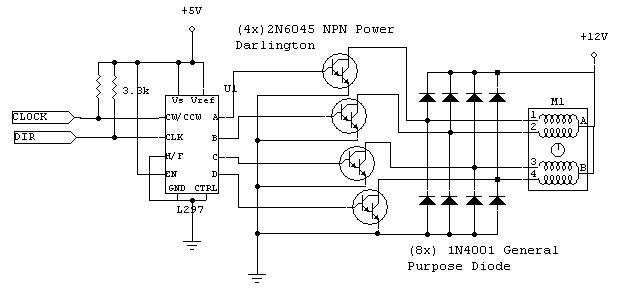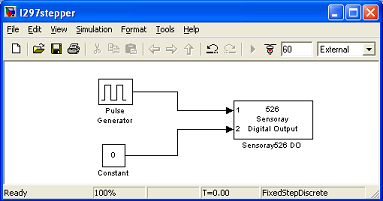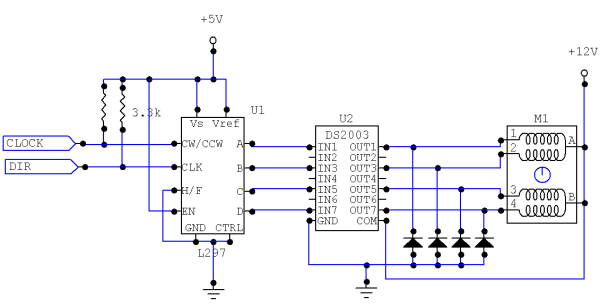Difference between revisions of "Unipolar Stepper Motor Driver Circuit"
m |
m (→What you need) |
||
| (13 intermediate revisions by the same user not shown) | |||
| Line 9: | Line 9: | ||
** [[media:L297.pdf|L297 Stepper Controller]] |
** [[media:L297.pdf|L297 Stepper Controller]] |
||
*Discrete Components |
*Discrete Components |
||
** (4x) 2N6045 NPN Darlington Transistor |
** (4x) [[media:2N6045.pdf|2N6045 NPN Darlington Power Transistor]] OR (1x) [[media:DS2003.pdf|DS2003]] |
||
** (8x) 1N4001 Diodes |
** (8x) 1N4001 Diodes |
||
** (2x) 3.3kOhm Resistors |
** (2x) 3.3kOhm Resistors |
||
| Line 20: | Line 20: | ||
The L297 has several inputs that can be generated by a PC/104 stack or other controller. This circuit allows you to control each step, in full-step mode. Meaning: You can tell it to move one step in either direction (of course you can make it move fast and it will continuously rotate). The two inputs are a direction and a pulse. In the next section you will find a program to control this using xPC. |
The L297 has several inputs that can be generated by a PC/104 stack or other controller. This circuit allows you to control each step, in full-step mode. Meaning: You can tell it to move one step in either direction (of course you can make it move fast and it will continuously rotate). The two inputs are a direction and a pulse. In the next section you will find a program to control this using xPC. |
||
[[image:unipolar stepper circuit schematic. |
[[image:unipolar stepper circuit schematic.png|center]] |
||
Here is the CircuitMaker file: [[media:unipolar stepper driver circuit.ckt|Unipolar Stepper Driver Circuit]] |
|||
{| align="center" |
|||
| [[image:unipolar motor driver.jpg|300px]] |
|||
| [[image:unipolar motor circuit photo.jpg|300px]] |
|||
|} |
|||
You may find the following diagrams useful when constructing this circuit: |
|||
{| align="center" |
|||
| [[image:L297 pinout.jpg|200px]] |
|||
| [[image:NPN pinout.png]] |
|||
| [[image:stepper wire colors.png]] |
|||
|} |
|||
===xPC Code=== |
|||
The program below is the simplest program for controlling the circuit above. The Pulse block dictates the speed of the stepper and the constant (1 or 0) sets the direction. |
|||
[[image:xpc stepper controller.png|center]] |
|||
===Alternative=== |
|||
An alternative method for building this circuit is using the [[media:DS2003.pdf|DS2003]] darlington array. It is lower power, but will save some space and is easier to construct. The circuit is exactly the same as above, except the transistors and half the diodes are inside the IC. |
|||
[[image:unipolar driver circuit ds2003.png|center]] |
|||
[[image:unipolar circuit ds2003 photo.jpg|center]] |
|||
Latest revision as of 10:50, 4 August 2006
This page presents a circuit for driving high-power unipolar stepper motors. Here you will find all the information needed to make your own. This circuit allows step-level control and can be easily modified for other modes of operation.
What you need
- Power
- +5v (low power)
- +12v (high power)
- ICs
- Discrete Components
- (4x) 2N6045 NPN Darlington Power Transistor OR (1x) DS2003
- (8x) 1N4001 Diodes
- (2x) 3.3kOhm Resistors
- Other
- PC104 or High-Level Controller
- 12v Unipolar Stepper Motor
Circuit Schematic and Photo
The L297 has several inputs that can be generated by a PC/104 stack or other controller. This circuit allows you to control each step, in full-step mode. Meaning: You can tell it to move one step in either direction (of course you can make it move fast and it will continuously rotate). The two inputs are a direction and a pulse. In the next section you will find a program to control this using xPC.
Here is the CircuitMaker file: Unipolar Stepper Driver Circuit
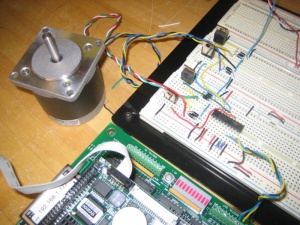
|
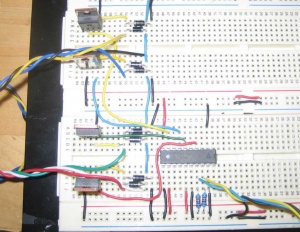
|
You may find the following diagrams useful when constructing this circuit:
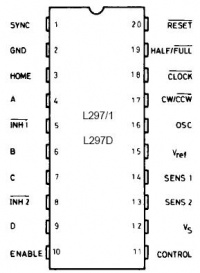
|
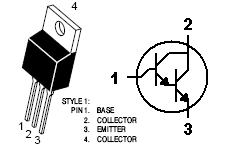
|
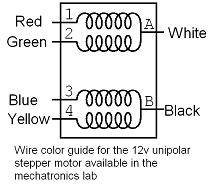
|
xPC Code
The program below is the simplest program for controlling the circuit above. The Pulse block dictates the speed of the stepper and the constant (1 or 0) sets the direction.
Alternative
An alternative method for building this circuit is using the DS2003 darlington array. It is lower power, but will save some space and is easier to construct. The circuit is exactly the same as above, except the transistors and half the diodes are inside the IC.
